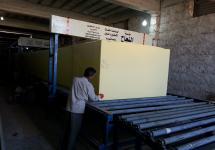Can you imagine your daily life without hot water supply? We think not. The best assistant in this difficult matter, of course, will be a boiler (water heater), designed to provide hot water and heat supply. And immediately a quite reasonable question arises - how, in fact, to make the right choice? Let's try together to figure out what is for your home.
At choosing a boiler(water heater), the main indicators should be carefully evaluated:
- Boiler type
- Heating element type;
- Power;
- Body material
Let's start with the main parameter - the type of boiler (water heater).
A type

Currently there are three main types of boilers:
- cumulative;
- flowing;
- bulk
Depending on the source of energy, boilers can be: gas and electric.
Most homes use an electric boiler. Such a device operates from a conventional electrical network, while not requiring additional connection to power supply lines. It's pretty convenient. However, in some regions, in order to save money, they choose gas boilers or, with high performance, for which they are not inferior to their electric counterparts. Gas boilers exist with open and closed chambers. Therefore, when choosing this device, you should also take into account the funds that you are willing to spend on buy a boiler.
Since most consumers still prefer electric water heaters, so today we will talk about the choice of just such devices.
Storage boiler

A storage water heater is a special tank filled with cold water, which is supplied under a certain pressure, for further heating to a set temperature using a heating element. In this type of device, the temperature range can be from 45 to 85 C˚. Temperature control is carried out both manually and using an electronic control unit. If the heated water has not been fully used, it gradually cools down to room temperature. Storage boilers can be gas and electric. In addition, such devices can be presented both in horizontal and vertical design. Storage boilers are installed exclusively on the wall.
Advantages
- large volume of water;
- low power consumption;
- no additional wiring is required during installation;
Flaws
- impressive dimensions of the tank;
- slow water heating

The flow-through boiler, in contrast to the storage analogue, has a small size, providing heating of large volumes of water. Such a device is capable of maintaining a temperature regime of 60 C˚. Water heating in flow-through boilers is carried out using a spiral heating element, covered with a special insulating coating. Temperature control is carried out using a control unit. As in the case of the storage boiler, the instantaneous version of the water heater can also be electric and gas. Due to its relatively small dimensions, the instantaneous water heater allows various installation options - in the kitchen (above or below the sink), in the bathroom (above or near it), hidden version (in the wall).
Advantages
- fast and timely heating of a large volume of water;
- reliable tank and ergonomic dimensions (does not take up much space);
Flaws
- excessive energy consumption (in the case of using the electric version of the boiler);

This type of water heater, as a rule, is installed in houses, in the absence of a central cold water supply system - summer cottages, townships, villages. A filling boiler is a special tank with a top lid, into which cold water is manually poured. As a rule, on the side such a boiler is equipped with a special thermostat, which allows you to set the desired temperature regime. The bulk boiler can maintain the temperature in the range from 25 to 80 C˚. The heating element of the filling boiler is located under the tap, which prevents its possible failure. Bulk boilers can be of two types: kitchen boilers and shower boilers.
Advantages
- ideal for rural areas in the absence of centralized cold water supply;
- ergonomics of the tank;
- low cost
Flaws
- possible overheating of the heating element
Tank shape
The shape of the tank is not an important parameter for choosing a boiler, but we will still consider it. Water heaters can be produced in three main tank shapes: cylindrical, thin (or slim) and rectangular.
The next parameter considered when choosing a boiler is the volume of the tank.

Boiler selection the volume of the tank is a priority, since you can immediately determine the intended purpose of the device. When choosing the volume of the tank, first of all, it is worth deciding on the volume of water that will be required to meet the daily needs of your family.
To correctly calculate the required volume of the tank, you can use the following data from the table below.

Modern water heaters differ depending on the volume of the tank: 400, 300, 200, 150, 120, 100, 80, 50, 30, 15, 10, 5. Choosing a boiler, it is worth considering the needs of each family member in the daily use of hot water.
Water heaters with a tank volume of 5 to 15 liters can be installed in the bathroom (for washing hands) and kitchens (for washing dishes), from 30 to 100 liters - for a bath (shower / bath), from 150 to 400 liters - for hot water supply Houses.
Based on the number of family members, experts advise choosing the following tank volumes:
- for 1-2 people - 30 and 50 liters;
- for 3 people - 50 and 80 liters;
- for 4-5 people - 80 and 100 liters;
- for 5-7 people - 120-150 l
Heating element type
Heating elements are designed to heat water in electric boilers. In modern models of devices, the following two types of heating elements can be installed:
- dry heating elements;
- wet heating elements
Dry heating elements are a heating element placed in a protective tube (glass, mineral or ceramic). Such heating elements are more reliable and durable than dry heating elements due to their resistance to corrosion and scale formation. They also differ in high cost.
Wet heating elements are also called submersible, since they are located directly in the water. Outwardly, such a heating element is very similar to the boiler that we all once used. This type of heating element is prone to corrosion and damage, frequent breakdowns and overheating. However, the cost of such a heater is more attractive compared to a dry heating element.

For guaranteed protection of the water heater from corrosion processes, manufacturers equip devices with a special protective anode (it promotes oxidation and dissolution of corrosion and salt deposits on the installed heater).
In addition, almost all models of boilers are equipped with a thermostat for adjusting the temperature regime and a thermometer with an indicator of the temperature in the tank.
The next equally important parameter boiler selection Is its power.
Power
The power of the device affects, first of all, the rate of heating the water. This means that the more powerful the boiler is, the faster it is able to heat the required volume of water. For most models of boilers, the power is 1.5 kW. At the same time, some manufacturers offer consumers boilers with a capacity of 1.4 kW and 2.0 kW.
Body material
Before as choose a boiler for home, you should carefully study other characteristics, such as the material of the case. The boiler body can be made of glass porcelain, titanium alloy or stainless steel. The material plays a rather important role in the selection, because the degree of protection of the tank from corrosion depends on its quality, and, accordingly, determines the overall service life of the product.

Currently, boilers with glass porcelain and enamel inner lining are in high demand. Enamelled tanks are an order of magnitude cheaper, however, and the service life of such devices is not long. When exposed to high temperatures, the enamel begins to crack, which means that soon such a boiler will become unusable. Stainless steel tank water heaters are more reliable and durable, as well as more resistant to corrosion. It is also worth noting that in boilers with a tank made of stainless steel, the walls are thinner, susceptible to possible water hammer (pressure drops), which often have a negative impact on the reliability of the entire structure.
At choosing a boiler it will not be superfluous to inquire about its heat-insulating layer, which is designed to maintain a high temperature of water in the tank without additional heating.
As you can see, before buy a boiler, it is worth stocking up on some baggage of information in order to be able to make the right choice in the future. Remember, the main thing is not the appearance, but the quality! We sincerely hope that with this article, we were able to replenish the necessary baggage of your knowledge in order for you to make a profitable purchase! Happy search!


